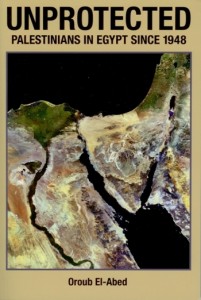|
Reviewed by Michael Sharnoff, Ph.D. Candidate at King’s College, London. While much research has been devoted to the plight of the Palestinians in Israel, the West Bank, the Gaza Strip, Jordan and Lebanon, a dearth of literature exists on the Palestinians in Egypt—despite the fact they have been living there for more than 100 years. Oroub El-Abed’s comprehensive analysis of the Palestinians in Egypt deserves special praise for helping shed new light on this much neglected topic in academia. A Ph.D. candidate in development studies at The Graduate Institute for International and Development Studies, El-Abed spent two years in Egypt conducting research for her book. Utilizing primary Arabic documents and field interviews with Palestinians, the book illustrates and assesses their status in Egypt from 1948 to the present. El-Abed notes that prior to Israel’s independence in 1948 there were approximately 75,000 Palestinians living in Egypt. Most had settled in Cairo and Alexandria and lived close to other Palestinians, and were from the middle and upper classes, and some had acquired Egyptian citizenship. Their residency was considered temporary, and many believed, with the encouragement from Arab governments, that they would return to Israel. However, after the first Arab-Israeli War in 1948, Egypt became responsible for the welfare of two separate Palestinian communities; the Palestinians living in Egypt proper, which numbered approximately 87,000 and the 200,000 Palestinians living in the Egyptian-occupied Gaza Strip, a small, densely populated territory seized by Egypt during the war. Palestinian living conditions in the Gaza Strip were harsh. They remained stateless, their travel was restricted, and an Egyptian governor ruled the territory with an iron fist. President Gamal Abdel Nasser attempted to improve the quality of life for Palestinians in the Gaza Strip by granting them free education in public schools and many worked as businessmen, merchants, mechanics, farmers, and fishermen. He also allocated subsidies for students to enter Egyptian universities and helped create the Palestine Liberation Organization in 1964, although the latter was more out of his desire to control Palestinian affairs than out of benevolence. After the 1967 War, the Gaza Strip fell under Israeli control and approximately 13,000 additional Palestinians entered Egypt. Their stateless condition persisted after Nasser’s death in 1970, and new, harsh measures enacted by President Anwar Sadat sought to draw clearer distinctions between Palestinian and Egyptian identities. Sadat revoked some privileges Palestinians enjoyed under Nasser and in 1978, he enacted a law which banned Palestinian children from free public schools, forcing them to switch to costly private schools. He also imposed Law 48, which prohibited Palestinian workers from the public sector. Palestinians were also viewed with suspicion and persecuted, particularly after Egyptian Minister of Culture Yusuf al-Sibai’s assassination by the Palestinian terrorist group Abu Nidal in 1978. Throughout the Mubarak years from the 1980s to the present, Palestinians continued to face discrimination, notably for their collective support for Saddam Hussein during the Gulf War. Palestinian welfare programs and PLO funds were reduced and thousands of Palestinians with Egyptian travel documents were denied entry into Egypt. Many Palestinians sought to avoid the challenges and hardships by marrying Egyptians in order to better their lot in life. Until 2004, however, Egyptian nationality could only be passed paternally. According to El-Abed’s interviewees, many Palestinian women have sought to marry Egyptian men in order to pass Egyptian citizenship onto their children. Since the Egyptian Nationality Law passed in 2004, Egyptian citizenship can now be passed maternally, as well as paternally. Although the law is not retroactive, El-Abed speculates as more and more Palestinians assimilate into Egyptian society, this process of “Egyptianizing” Palestinians could solve Egypt’s Palestinian issue in the near future. (p. 184) While El-Abed does an excellent job illustrating the difficulties and obstacles Palestinians faced in Egypt, the fact that Egypt recognized the Gaza Strip as a distinct entity from 1949 to 1967 and had no intention to annex it raises an important question. President Nasser claimed to champion Arab unity and Palestinian rights, yet during most of his presidency, the Gaza Strip remained under his control. A fundamental disconnect existed between the ambitions of Nasser’s Arabism while maintaining a policy of occupying nearly a half a million Palestinians, keeping them stateless, and denying them citizenship and equal rights with Egyptians. Nasser had confessed both before and after the 1967 War that he had no intention to liberate Palestine, which would facilitate the return of Palestinians to their homes. Even if the Palestinians themselves preferred to return rather than receive greater rights in Egypt, what justification did Nasser use to prevent Palestinian autonomy or independence? Although not the central focus of her study, it would have been an interesting anecdote if El-Abed had examined Palestinian reactions to this paradoxical circumstance. Treatment of Palestinians in Egypt remains largely a marginal topic in Middle East studies, but thanks to El-Abed’s solid work, a better understanding is now available. Unprotected is recommended to those interested in gaining a more in depth grasp of the relationship between Palestinian and Egyptian history, politics, and human rights. |


 Unprotected: Palestinians in Egypt since 1948
Unprotected: Palestinians in Egypt since 1948

